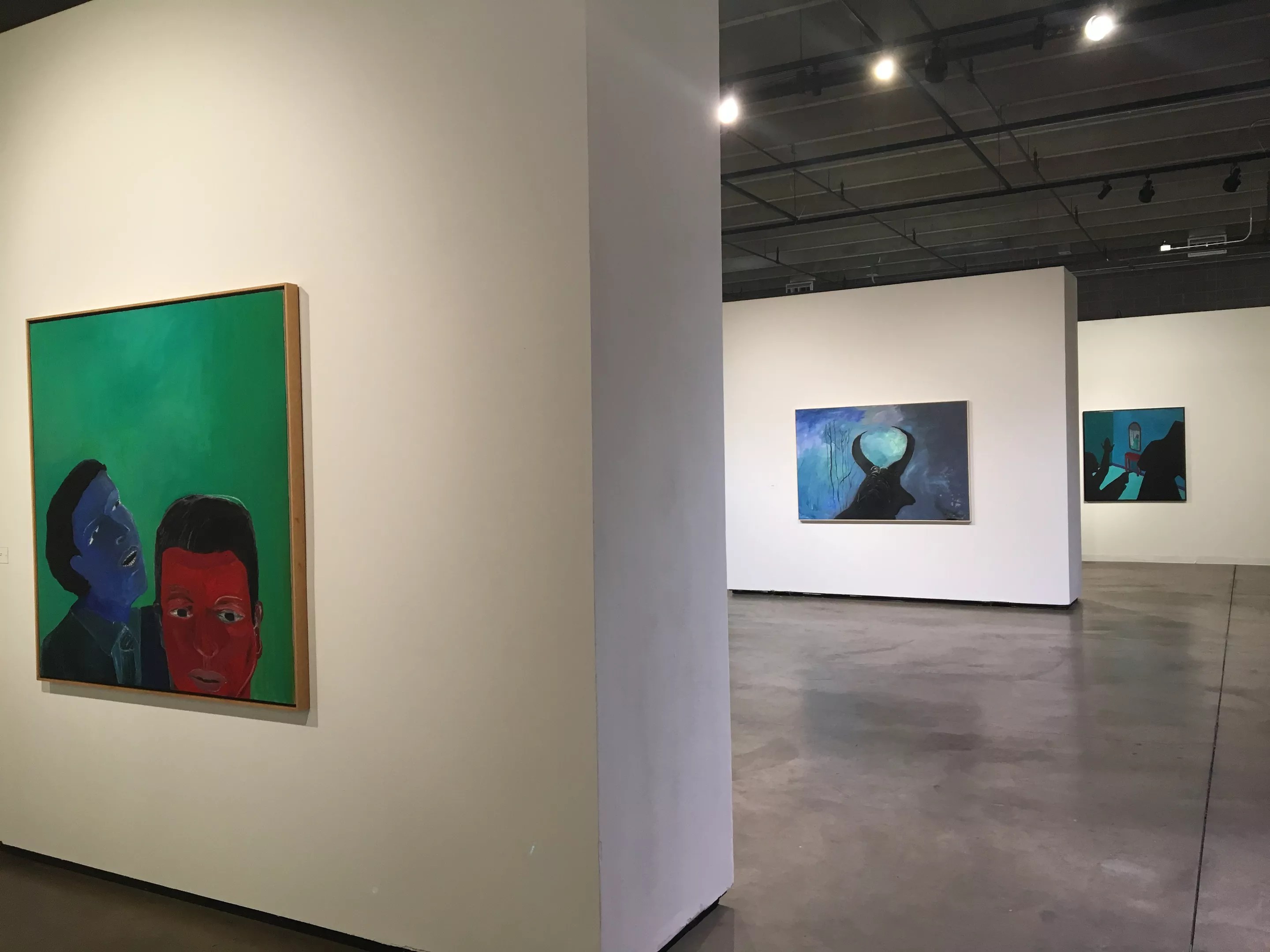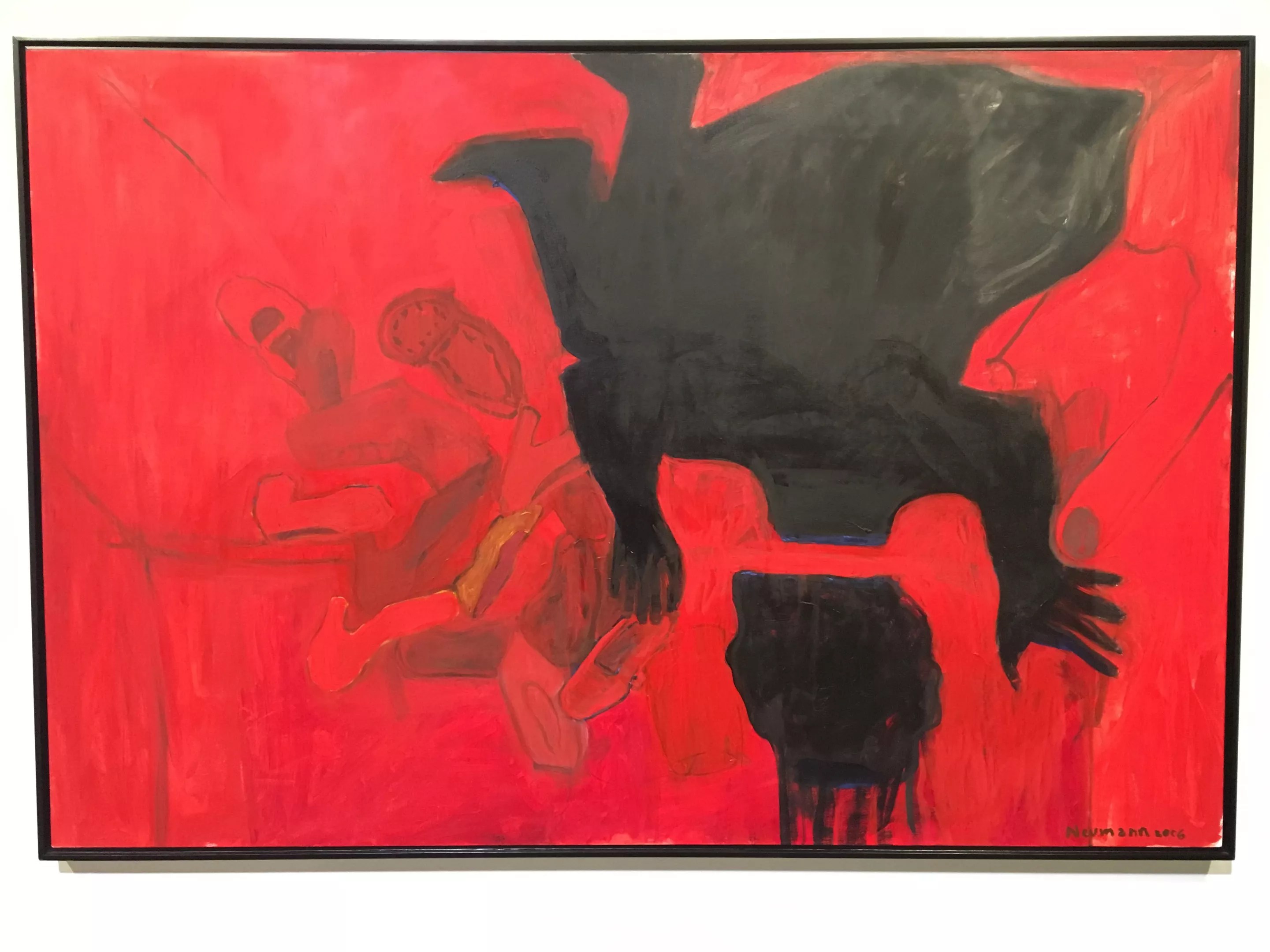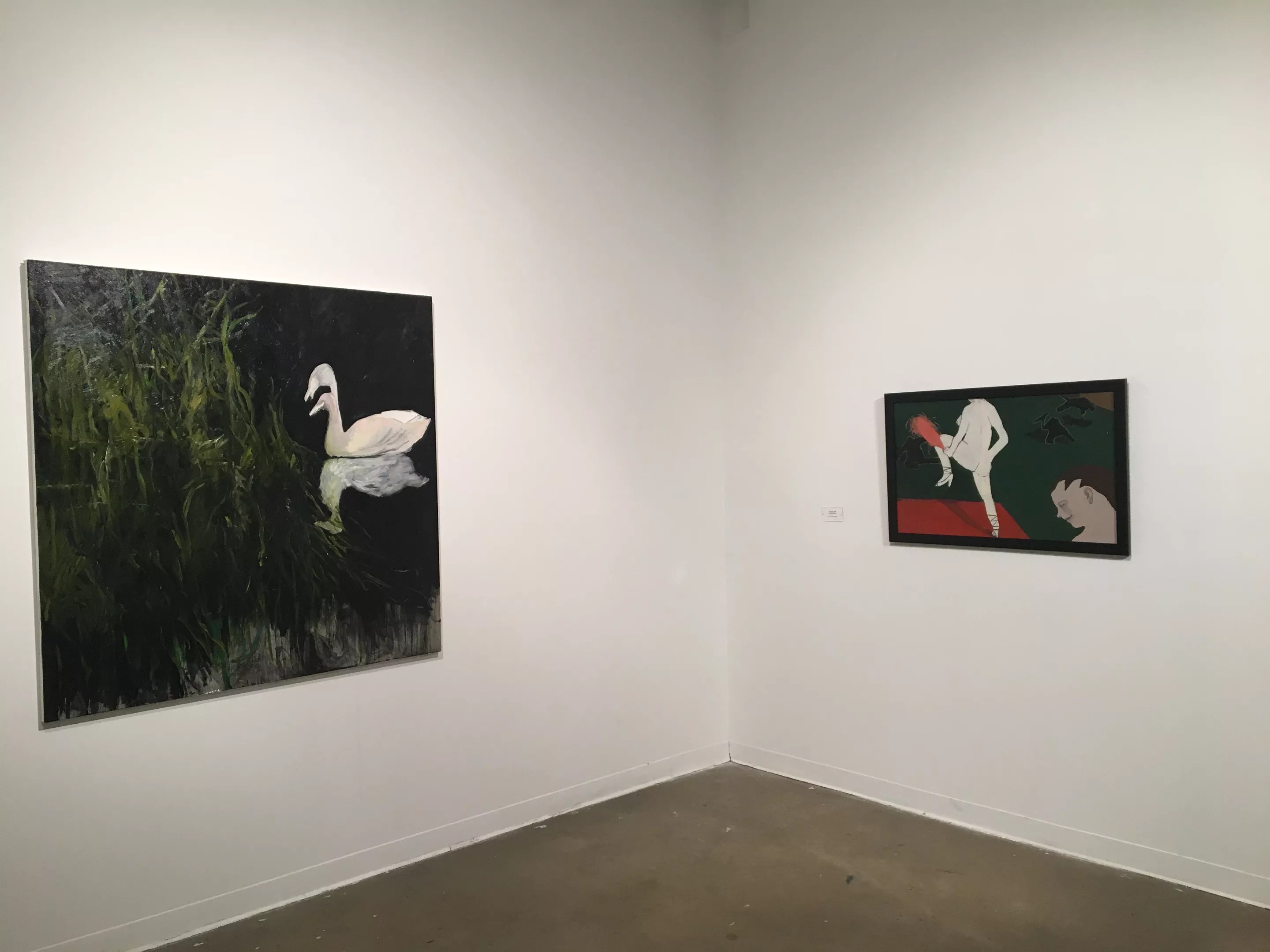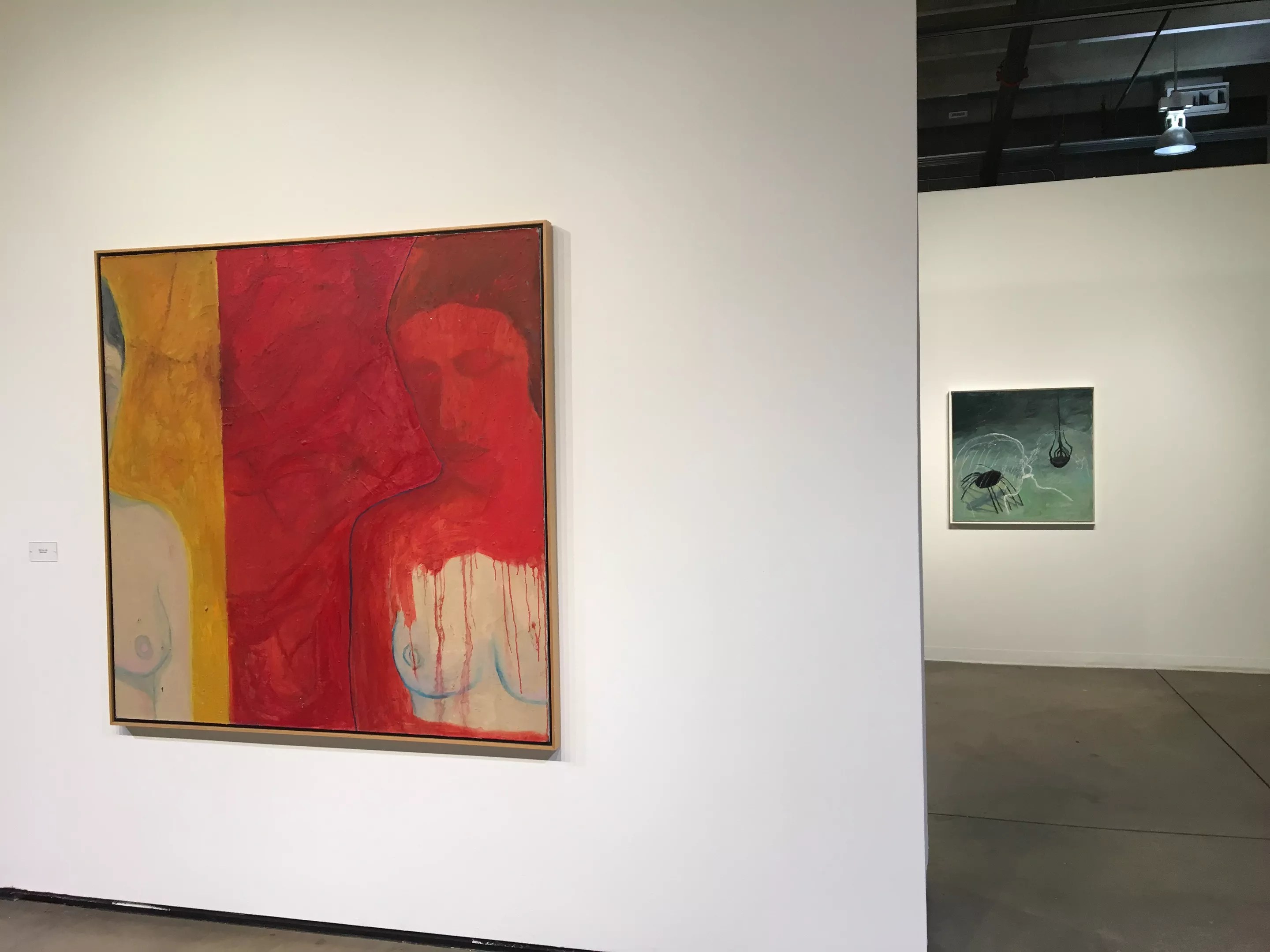
Robert Delaney

Audio By Carbonatix
This fall’s exhibition schedule has been filled with solos, surveys and retrospectives dedicated to masters of contemporary art in Colorado, with a tilt toward artists who’ve been active over the past thirty or forty years. The roster includes Elizabeth Yanish Shwayder, Virginia Maitland, Linda Fleming, Emilio Lobato, Robert Mangold, Scott Chamberlin, Paul Gillis, Frank Sampson and the late John Fudge. But even in this heady company, Margaret Neumann, the focus of Margaret Neumann: What Lies Between at RedLine, stands out because of how contemporary many of her paintings still seem. Though some might be decades old, they look super-fresh – fresher than they ever did, I think.
Neumann was born in 1942 in New York City to European refugees of the Holocaust. Her father, Alfred Neumann, took a job as director of Jewish Family Service, and the family moved to Denver in 1948. “My early childhood was very chaotic,” Neumann recalls. “We spoke German at home and moved a lot. But from when I was at a very early age, my parents, who were very cultured, exposed me to museums, and art made me feel at home somehow.”

Installation view of Margaret Neumann: What Lies Between at RedLine.
Robert Delaney
In 1960, she entered Colorado College, where she studied with Mary Chenoweth. Neumann does not recall their interactions kindly: “She was really mean to me,” she says. After a couple of years in Colorado Springs, she did a summer semester at Columbia University, then persuaded her parents to let her transfer to the University of Colorado at Boulder, where she earned her BFA in 1964. “Those were some of the best years of my life,” says Neumann. She moved to the East Village after graduation, then came back to Boulder in 1967 for graduate school, completing her MFA in 1969.
Many stars of Denver’s art scene in the ’80s and beyond got their start in Boulder in the late 1960s. There was the Armory Group, of which Neumann was a part, as well as other collectives, notably Criss-Cross and Edge. “Dale [Chisman] was there then,” Neumann recalls, “and Clark [Richert], John Fudge, Joe Clower, John De Andrea, Susie Hankin, Susie Katz, Bruce Brown, George Woodman, Betty Woodman, Charles DiJulio… . It’s not that our work was all the same, because it wasn’t; it was our mindsets that were all the same. It was a wonderful time when everything was opening up. Art was a calling for us then. I think today it’s a career.”
By the late 1970s, a number of these artists had settled in Denver, and Neumann joined with some old friends, including Paul Gillis and Andy Libertone, to found the Spark Gallery cooperative in 1979. It was named for her dog, Sparky. In the 1980s, she joined Pirate, where she remained a member for a couple of years.”I don’t know how I stayed so long,” she says. “The guys were always drunk or stoned, they were a lot of trouble, and they treated me like a suburban housewife!” Through it all, she continued to paint. Neumann’s work was showcased in many exhibits, including a solo at the Museum of Contemporary Art Denver when it was located in Sakura Square; that show was curated by then-director Cydney Payton.

“Goya and Me,” by Margaret Neumann.
Robert Delaney
The RedLine display is Neumann’s largest and most significant exhibition, though, and it’s magisterial. The show was curated by Simon Zalkind, who has known Neumann for forty years. Zalkind looked over Neumann’s oeuvre and selected works dating from the 1960s up through pieces created this year. In his exhibition design, he chose not to arrange the works in chronological order, but to instead put together those that resonated visually. Zalkind’s seasoned eye for aesthetic relationships is the key to his success as a curator. Interestingly, despite this visual gift, Zalkind is probably more interested in the dark psychological narratives suggested by Neumann’s paintings, and it was this quality that first attracted him to her efforts. I see Neumann as part of the international neo-expressionist movement of the ’70s and ’80s, though Zalkind disagrees. Despite absorbing a range of influences, he says that Neumann has arrived at a point of view all her own, and that’s unquestionably true.
Neumann expressively depicts the figure and, just as significant, she handles the brushwork as though she were doing an abstract. To me, this was the revelation of the show: Despite all appearances, Neumann is an abstractionist…sort of. The figurative element does dominate the composition and introduces the narrative, but her depictions are often little more than profile lines or loosely defined forms, the paintings otherwise brushy and drippy abstractions.

Margaret Neumann’s “Swan” (left) and “Fan Dancer.”
Robert Delaney
The figurative components make the paintings decidedly disquieting, and I mention that to Neumann. “People say that, but I don’t know why they do,” she replies, deadpan. As she’s telling me this, I’m looking at “Goya and Me,” which depicts a figure that has been decapitated. I point that out, but she just laughs in response. “Oh, that’s about Goya, who I think is the finest artist and my favorite,” she says. “He’s been really important to me, and so has Kiki Smith, Susan Rothenberg and Philip Guston.” For “Goya and Me,” Neumann has covered most of the canvas with a painterly red field that includes ghostly images of discarded shoes floating in the background. (For Zalkind, this is a direct reference to the Holocaust, and I see what he means.) Descending from the top left of the canvas is the black outline of an upside-down woman, her head separated from her body and depicted as though falling to the floor. There’s nothing gory about the figure – it’s too sketchy – but it does capture the edgy mood that most of Neumann’s pieces conjure up.

“Kiki Cries” (left) and the show’s title image, “What Lies Between,” by Margaret Neumann.
Robert Delaney
The gorgeous “Pink Swimmer,” which is all but a Rothko, backs up the observation that these are essentially abstract paintings with figurative intrusions defining them. There’s a thick pink band across the top, an orange one across the bottom, and a narrow yellow stripe in between. And there’s something else: In the center of the orange band is a black silhouette of a man, his face below the yellow stripe, with another face carried out as a bare-bones outline above. Despite the lyrical colors, the implication of a drowning man is impossible to avoid in this smartly conceived composition.
Other standouts include “Push,” which may show a man drowning someone in a bathtub; “Kiki Cries,” a pair of sad maiden figures inspired by Smith; and an homage to Guston, “Voyage Long Time Ago,” in which a man bleeds from a head wound. (Did somebody say “Unflinching non-decorative”?) Even when Neumann offers subjects that have no negative associations, such as the red, richly painted fruit in “Cherries” or the white bird in “Swan,” her pieces still have the tinge of a nightmare. “I’ve battled depression all my life, and that comes through in the work,” she explains. “For a long time, I didn’t get much positive feedback about what I was doing, but I felt if I can’t do what I want to do as a painter, I might as well be a stockbroker, so I just let the paintings lead me where they were going.”
Where they landed makes for a very impressive show.
Margaret Neumann: What Lies Between, through January 6, RedLine, 2350 Arapahoe Street, 303-296-4448, redlineart.org.